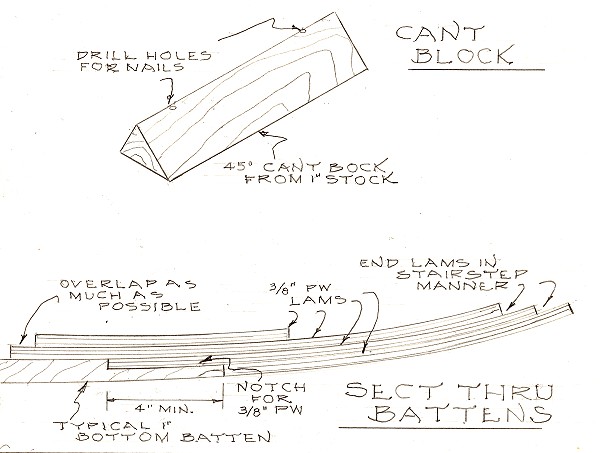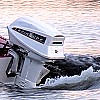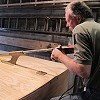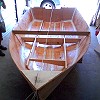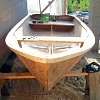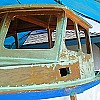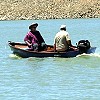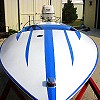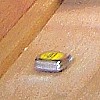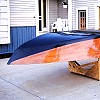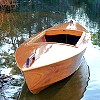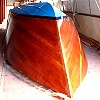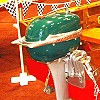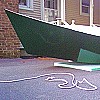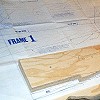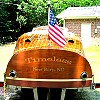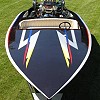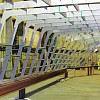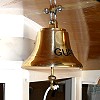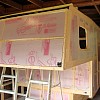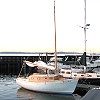

A place to share YOUR boat building story
Glen-L Marine Designs - 9152 Rosecrans Ave. - Bellflower, CA 90706
 In this issue
In this issue
-
Dreams Realized by Gayle
Brantuk
-
Boats on a Lake by Markus
Hosseini
-
My Tubby Tug Build by Doug
Wade
-
Designer's Notebook: Strengthen
Your Bottom?
-
Sale-ing by ArtDeco
-
Photos posted since the last
WebLetter...
-
Build a Boat in a Week by Bob
Spiess
-
Shop Talk: Savy Storage for Small
Stuff
-
Recent email
-
The Captain's
Parrot
GLEN-L Update
- This is the first WebLetter since Gayle and I returned from the 2010 Gathering of Glen-L Boatbuilders, or "G4" as the regular attendees have dubbed it. I honestly can't adequately express just how interesting and how much FUN these Gatherings are. And it's all due to the wonderful, personable and generous volunteers who populate the Glen-L Boatbuilder Forum who have taken it upon themselves to plan, organize and execute on their own this valuable event each year. If you made it to G4, be sure and log onto the Forum and express your thanks to the organizers, and check out the plans for G5 - it looks like it's shaping up to be another spectacular time for all who can join in on the fun!
- Did you like this WebLetter? The WebLetter is prepared between other responsibilities and the finished product depends a lot on input from Glen-L builders. If you have a story to tell, don't be bashful, our readers are interested in your boatbuilding project. Don't worry about grammar, spelling, etc. Three people proofread the WebLetter and we often make corrections. Email your story, attach photos with captions. Seeing other projects is a great help to builders. Thanks to those of you who contributed to this WebLetter.
- A reminder... Christmas is coming and friends and family would like to get you something you REALLY want. You might want to print out some pages from the Glen-L Online Store and leave them laying around, with appropriate circles and arrows... just a thought.
Until next month . . .
Editor
Dreams Realized
by Gayle Brantuk
FOURTH GATHERING OF GLEN-L BOATBUILDERS
Pride of achievement is the true
reward of building a boat. It's evident by the look on
the faces of every builder at each Gathering we've had
for the past four years.
This pride comes from a job well done, from a goal achieved,
a dream realized. The double-takes they get on the water and
the folks asking "how old is your boat? These
experiences are what make it all worthwhile. And the guys I
talked to say it was worth every minute.
September 24-26 was the fourth Gathering of Boatbuilders organized by
the members of the Glen-L Boatbuilder Forum. Each year I write
about this event and how wonderful it was, how it gets better
each year, about all the beautiful boats and so on. All this
is true, but there's a much deeper thread to G4 as
it's now affectionately called.
It's not just about the beautiful boats that guys have
built with Glen-L boat plans, or having fun riding in those
boats, the wonderful people that attend or the great
food.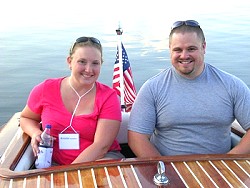 It's about people
living and fulfilling their dreams. And there's always a
story behind the boat, and to me that's the best part.
Rory Hamilton is a third generation Glen-L boat builder. His
inspiration is his grandfather who built the Sea Knight and he is determined to build
a boat just like Grandpa's. He brought a photo album to
the Gathering showing photos of his family's boats and
some of the start of his own project. I could feel Rory's
passion. This is more than just a boat to build. He's
building his dream and carrying on his family's
tradition. And his wife Kristen was right there with him
providing encouragement.
It's about people
living and fulfilling their dreams. And there's always a
story behind the boat, and to me that's the best part.
Rory Hamilton is a third generation Glen-L boat builder. His
inspiration is his grandfather who built the Sea Knight and he is determined to build
a boat just like Grandpa's. He brought a photo album to
the Gathering showing photos of his family's boats and
some of the start of his own project. I could feel Rory's
passion. This is more than just a boat to build. He's
building his dream and carrying on his family's
tradition. And his wife Kristen was right there with him
providing encouragement.
Then there was Mary and Bernard. This couple came from
Wisconsin where they own and run a resort. They closed down
the resort and came to the Gathering for the first time. On
Saturday, when we got all of the boats out on the water so we
could get some good video, Mary and Bernard were standing on
the docks wondering what they should do. Bill Edmundson told
them they were welcome to hop in the back of his 24' Tahoe with us.
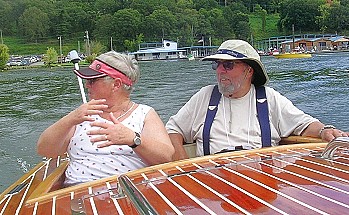 We were out on the water for close
to an hour with about 30 boats running and having a great
time. I looked back at Mary and Bernard and with a huge smile
and two thumbs up, Mary said "I'm living my dream
right here in this boat".
We were out on the water for close
to an hour with about 30 boats running and having a great
time. I looked back at Mary and Bernard and with a huge smile
and two thumbs up, Mary said "I'm living my dream
right here in this boat".
Seriously, how many people get to ride in a 24' mahogany
runabout that was built by hand, not in a factory, but by the
guy driving… with his own two hands… with the
sweat of his brow? It's an awesome experience.
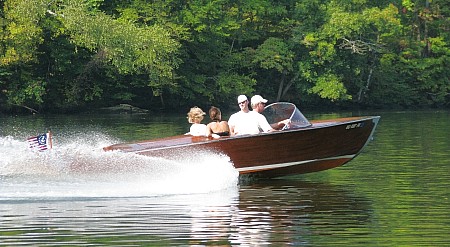
And then there's Dave Lott who recently completed
building his Riviera, a 20' classic mahogany
runabout. Dave built this beautiful boat in only 11 months
and it's truly impressive. The story behind his boat is
lengthy and detailed on his blog, but the bottom line is that
building his boat was an opportunity to share his Christian
faith and testimony.
I also had an opportunity to take a ride in Gary
Steinkamp's Missile 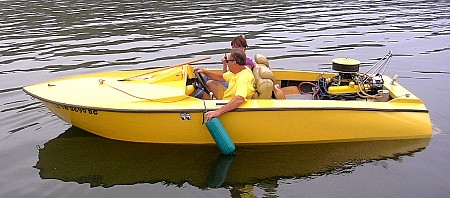 which is a 16' inboard speed
boat. On the dash of Gary's boat is a brass plaque that
reads "Gene Steinkamp - May his spirit be with us".
Gene is Gary's brother who was in a wheelchair for 50
years because of polio from which he finally passed. He
helped Gary build the Missile… you can imagine that
this is more than just a "boat" to Gary.
which is a 16' inboard speed
boat. On the dash of Gary's boat is a brass plaque that
reads "Gene Steinkamp - May his spirit be with us".
Gene is Gary's brother who was in a wheelchair for 50
years because of polio from which he finally passed. He
helped Gary build the Missile… you can imagine that
this is more than just a "boat" to Gary.
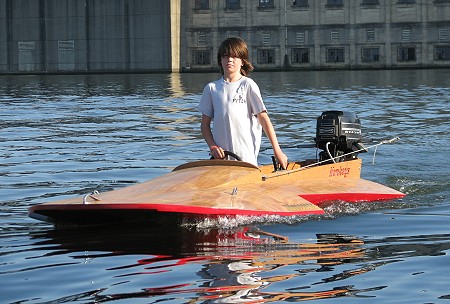 Who can forget young 12-year old
Collin who raced his 10' Super Spartan up and down the lake all
weekend? That boy handles his boat like a pro and had a ton
of fun using it. I even understand he's quite a captain
with the bigger boats as well.
Who can forget young 12-year old
Collin who raced his 10' Super Spartan up and down the lake all
weekend? That boy handles his boat like a pro and had a ton
of fun using it. I even understand he's quite a captain
with the bigger boats as well.
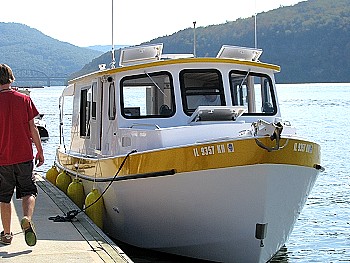
For years, many of our WebLetter subscribers followed the stories of Ray Macke and his adventures
in his Cabin Skiff. Ray has (so far) logged over
27,000 miles and 1587 hours on his 16' Skiff traveling
various intercoastal waterways. For G4, Ray brought his new
boat, the 27' True Grit that he's named
"SeaQuinn". We've watched Ray's build
online and know that his wife is much happier with a larger
boat with better accommodations. This isn't just a boat -
this is Ray and Vickie's transport to worlds unknown, to
adventures that await, to deepening the bonds of their
marriage.
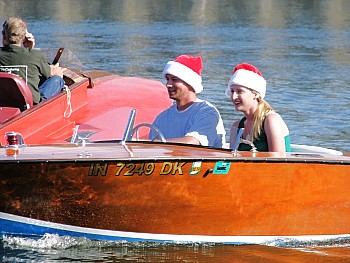
And of course,
there's Chris who came to his first Gathering last year
with his wife Heather along with photos of the beginning of
his boat. Chris is one of our younger builders and this year
he brought his finished Zip which is one of our most popular
14' runabout designs. Chris gave ride after ride in his
pride and joy which he named "First Born". You
could just feel the well-earned pride this young man has. He
and Heather even took photos with Santa hats on for their
Christmas cards.
Those are just some of the stories. There are many more and
that's to me one of the best things about our Gatherings;
getting to know the people behind the boats. These folks are
family to us here at Glen-L and we treasure the friendships
we are building.
These boatbuilders have much to be proud of. They started
and finished building a boat that they can be truly proud of.
They had a goal, a dream and they saw it through to
completion.
All of us at Glen-L are grateful for each of you who
attended G4 and thank you for making this event the highlight
of our year. If you weren't able to make it to this
year's Gathering, we urge you to make it to G5 because you'll kick yourself if
you don't! See you next year!
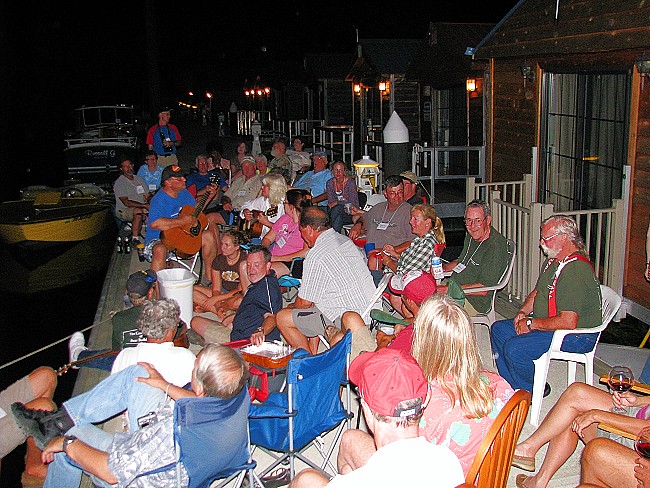
Editor's Note: See more from Gayle in the Glen-L BLOG.
Boats on a Lake
by Markus Hosseini, Roving reporter
Lake Oswego, Oregon
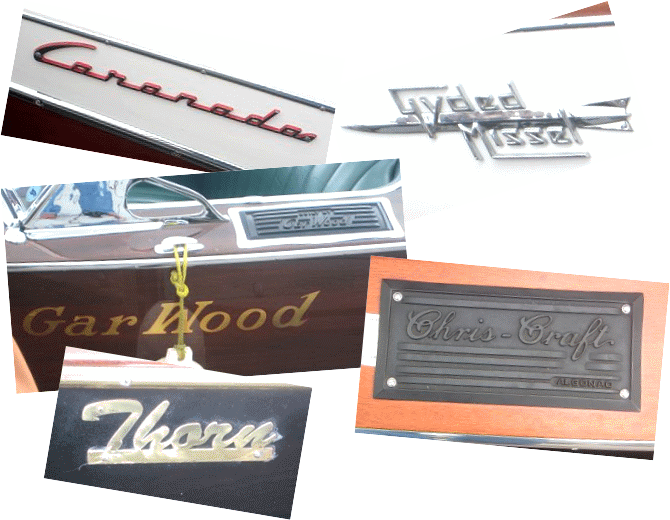
LAKE OSWEGO – The Oswego Heritage Council will
host its 11th annual Collector Car and Classic Boat Show
Sunday at George Rogers Park. An estimated 250 classics,
rods, sports and special interest cars and 40 classic boats
will be on display from 10 a.m. to 3 p.m. on the corner of
Ladd and South State streets. Boats also will be on display
at the nearby Lake Oswego Corporation Docks on State
Street.
My plan was that 2010 would be the
year that I made it to the Port Townsend Wooden Boat Show.
I'd been online to see about hotels and such and printed
out information on likely's. But then it turned out that
the most practical time to visit relatives on the East coat
would be during the event, so another year missed. I grumbled
about this to my wife, who said, "Why not go to the Lake
Oswego Boat Show, it's this week?" I didn't have
great expectations, but decided, "why not".
As it turned out, I was pleasantly surprised. There were
over 40 classic boats on display in a beautiful setting, we
had a wonderful day looking at classic wooden boats. Because
I know that readers of the Glen-L WebLetter love to look at
wooden boats, I took lots of pictures. There were no
Glen-L's among those on display, but these classic
originals should provide lots of ideas for those who are
building their own “classics”.
My Tubby Tug Build
by Doug Wade, Toronto, Canada
I first began building my Glen-L Tubby Tug early in the spring of 2008
when I turned the plans into a kit by cutting out every piece
that I could. Other projects restricted Tubby Tug building to
the winters.
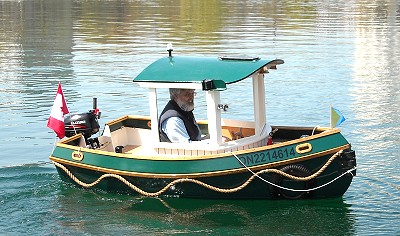 During the winter of
2008 - 09 I insulated a thirteen and a half foot by nine and
a half foot portion of my small single car garage and this
area became my boat shed. I completed the hull and painted
the exterior that winter. I also built the front of the pilot
house and used a router to make hawse pipe covers and the
ship's wheel.
During the winter of
2008 - 09 I insulated a thirteen and a half foot by nine and
a half foot portion of my small single car garage and this
area became my boat shed. I completed the hull and painted
the exterior that winter. I also built the front of the pilot
house and used a router to make hawse pipe covers and the
ship's wheel.
Building resumed November 2009; with seven foot headroom in
my boat shed I had to build the pilot house in the boat
because there was not enough room to lift the completed pilot
house into the boat. The boat was completed the end of
February 2010. I enjoyed every hour spent on this project and
have no idea how many hundreds of hours I spent on it.
My Tubby Tug has full running lights and a solar panel to
keep the battery topped up. The steering is homemade old
fashion drum and cable. To add play value a fire monitor is
powered with a high pressure 12 volt pump. I used Interlux
Brightsides paint, Maas epoxies and marine ply bought at
Noah's Marine in Toronto Ontario.
This was my first boat building exercise and one of the many
pleasures was the many things I had to learn such as the fact
that sand paper is a cutting tool and when dull it should be
discarded. Building a boat is easily within the skill level
of most people if it is simply viewed as an endless list of
doable tasks.
My wife fears that I am now an addicted boat builder and I
already have plans for two more boats. My problem is a lack
of space for storage of completed toys.
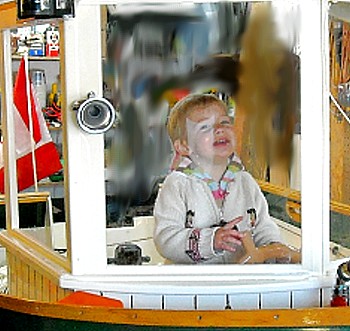
Editor's Note:
See photos of the custom touches Doug made
to his Tuggy Tub in Customer Photos.
Designer's Notebook: Strengthen Your Bottom?
|
Sale-ingSummertime is nearly overEnd of all the boating fun Though I know it’s not forever I’m still feeling kind of glum But now it’s time for planning Winter’s boat building work Doing boat mods and upgrades Those are some of winter’s perks Stores change their inventory Shifting space to winter things Summer items are reduced That’s a good that winter brings Time to look for boating bargains Watch for end-of-summer sales Get epoxy, paint, tools and ply Plans for new boat building tales Keep your boating spirit up Do the work you’ve put on hold If your own weather permits Start that new boat, be bold! So, my friend, as the story goes Tote that barge and lift that bale But keep your eyes open ‘cause Boat stuff’s ON-SALE! -ArtDeco |
Photos posted since the last WebLetter... |
Build a Boat in a Week
by Bob Spiess
Well my summer boat building
project is over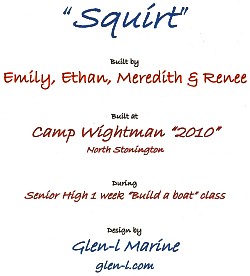 and it was
a complete success. I was a camp counselor and did a
"Build a Boat in a Week" class with 80% senior high
school girls in the class (it can be done). They did a great
job and are very proud of their accomplishment. I finally
chose the Glen-L Imp (the class named it the
"Squirt") after talking with you as it had real
style, good lines, and would make the class proud. The girls
learned a lot about epoxy, fasteners, power tools, building
frames, etc, and boats in general. What excitement at the
launch ceremony at the end of the week when it slid into the
water.
and it was
a complete success. I was a camp counselor and did a
"Build a Boat in a Week" class with 80% senior high
school girls in the class (it can be done). They did a great
job and are very proud of their accomplishment. I finally
chose the Glen-L Imp (the class named it the
"Squirt") after talking with you as it had real
style, good lines, and would make the class proud. The girls
learned a lot about epoxy, fasteners, power tools, building
frames, etc, and boats in general. What excitement at the
launch ceremony at the end of the week when it slid into the
water.
I promised the class that I would bring the boat to the
Mystic Seaport "Antique Marine Engine Exposition"
August 21-22 with my 1939 Elto "Handitwin" on the
stern. That all happened last weekend with total success.
There were 296 exhibits at the Seaport and Squirt was in
front of them all. In other words, the public needed to pass
Squirt and me to get to see everything else.
I have never talked with so many people for so many hours in
a long time. Your IMP was very popular and Glen-L was given
full credit for the design. Some people were surprised to
know that Glen-L was still in business and www.glen-l.com was a very popular address
for me to give out. We had many teachers (especially shop
teachers) stop by and they were very pleased to know that
some people are still interested in seeing young folks learn
to build with their hands. Many boat lovers commented on the
excellent design of IMP and wanted to know if this boat was
for sale.
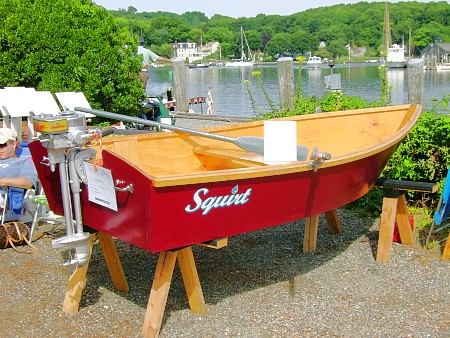
The class actually donated the boat to the camp for use as a
trainer in rowing and general boating safety for the younger
age children in years to come. I have included some pictures
and posters for you. I have enjoyed discussing this project
with you all at Glen-L and thank you for all the help and
plans.
Safe boating,
--- Bob
 you can do it!" |
Shop Talk: Savy Storage for Small Stuff
STORAGE POCKETS FOR SKINNY THINGS
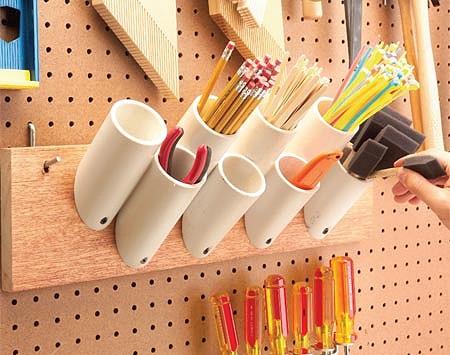
Saw off short pieces of 1 1/2", 2" or 3" PVC plumbing pipe with 45-degree angles on one end.
Screw them to a board to hold paintbrushes, pencils, stir sticks and just about any other narrow paraphernalia in your garage or workshop.
Mount them by drilling a 1/4-in. hole in the angled end, and then drive a 1-5/8-in. drywall screw through the hole into the board.
CANNERY ROW HARDWARE STORAGE
Don't recycle those steel or aluminum cans quite yet. Set
aside a few months’ worth of fruit and coffee cans and
put these cannery rows to work organizing all of the small
hardware in your shop. All you need are some homemade wood
clips and a chunk of 3/4-in. plywood screwed to a wall.
To make the clips, rip a 3/4-in.-thick board into
1-3/8-in.-wide strips. Saw or rout a 3/8-in. x 1/4-in. rabbet
along one edge. Drill 1/8-in. screw holes every 3/4 in. and
then cut off 3/4-in.-wide clips. To mount the clips and cans
on the plywood, screw on a clip, notch end down, then set a
can on the clip and screw on a second clip overlapping the
can's rim about 1/4 in.
That’s it! Keep adding clips and cans until every
screw, bolt, nail and nut has a can to call home. Label the
cans, and keep one loaded with surplus clips and screws for
adding on.
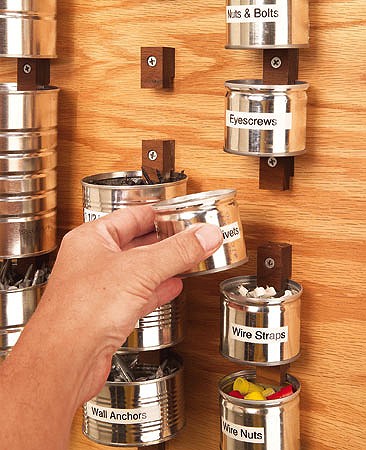
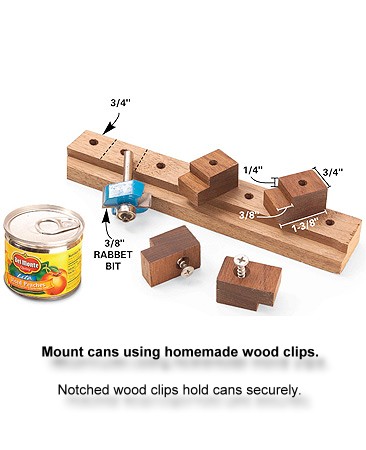
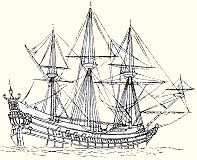
Recent email:
Subject: Another TNT from the plans by Glen-L
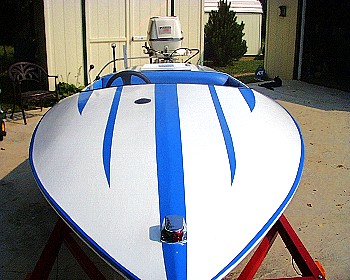 I recently finished
this TNT. I changed the deck a bit to give it
a more sporty look. The boat took me exactly two months from
start to finish working evenings and weekends.
I recently finished
this TNT. I changed the deck a bit to give it
a more sporty look. The boat took me exactly two months from
start to finish working evenings and weekends.
I have never built a boat before and I am not a woodworker
so if I can do this, anyone can.
-- Bill Snyder
Greeneville, Tennessee
Subject: Acapulco Camper
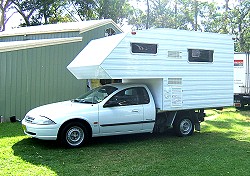 Hi Guys. Thirty five
years ago I built one of your campers and put it on a Ford
f100 truck. During the last two months I built your Acapulco to fit on my Ford Falcon
trayback ute.
Hi Guys. Thirty five
years ago I built one of your campers and put it on a Ford
f100 truck. During the last two months I built your Acapulco to fit on my Ford Falcon
trayback ute.
I modified the front to give it a different look and also
modified it to fit on the trayback.
What do you think?
-- Bob Hodkinson
Yanderra, Australia
P.S. I am 68 years old.
Subject: Fisherman
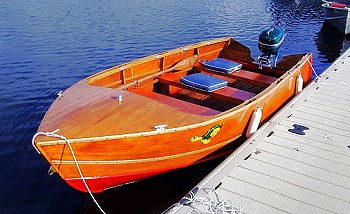 The previous owner had
put a false floor in it which did not allow any possibility of
getting water from under the floorboard, which caused some
problems. I removed the floor and took the boat to bare wood
inside and out. I had to do some improvising on the bottom at
the transom, but the end product is well worth it.
The previous owner had
put a false floor in it which did not allow any possibility of
getting water from under the floorboard, which caused some
problems. I removed the floor and took the boat to bare wood
inside and out. I had to do some improvising on the bottom at
the transom, but the end product is well worth it.I have run the boat with a 1950 Mercury KG7, a 1951 Mercury KG4, a 1952 Mercury KH7, and a 1953 Mercury Mark 20. The GPS showed 28 MPH with the KH7, and the boat handles well. I showed this boat at the Chicago Boat and Travel Show this year, and heard a lot of nice comments.
-- Dave Wilson
Subject: Thank you
Have a nice week
-- Joel Bouchard
Napierville, Quebec, Canada
Subject: Boat Plan Puzzlement
Still scratching my head, I attached the keel, which tied the stem to the transom across all the forms. At this point I was taking it all on faith, hoping the written instructions were going to work.
After that point, I sat down and looked at it for awhile. (I read Payson's book on Instant Boats, and he finds a 'thinking chair' to be an essential part of the shop. Now I know what he meant.) After some time in the chair looking from the plans to the barely attached pieces on the shop floor in front of me, the light clicked and I could see how the rest had to fit together.
The rest of the inverted construction phase went pretty well. The part I most feared, getting the side planking to meet on the bow, came together just fine. The gap at the plywood's end ranged from zero to 1/8". The plywood screwed down to the stem itself tight with no odd bends or twists at all.
I just put the fiberglass on the bottom this morning. I have no doubt I will be able to finish this project in good order. My next boat is going to be a Minuet. No straight lines anywhere, which is what prompted me to try something simpler (and I wanted a fishing boat anyway).
If the Minuet turns out to not be big enough, I'll build a Fancy Free, or a similar boat.
On that subject, others who favor stitch & glue have called the chine-logs and frame system old-fashioned and out of date. You carry plans for both construction methods. It might be useful if someday you could go through the advantages and disadvantages for both methods. The only stitch & glue boat I'm familiar with was a nightmare of sanding tight internal curves smooth enough to have a hope of getting the fiberglass tape to lay down flat. But the chine logs that were supposed to be oh-so-hard to cut correctly took about 30 seconds each on the table saw. The area that didn't come out quite the way I thought it should took another minute on each side with a power plane. "This is supposed to be difficult?" I thought. Quite a change from that first "holy cow!" moment.
-- Michael Spangler
Soap Lake, Wshington
The Captain's Parrot
A magician was working on a cruise ship in the
Caribbean. The audience would be different each
week, so the magician allowed himself to do the same
tricks over and over again. There was only one
problem; the captain's parrot saw the shows each
week and began to understand how the magician
performed every trick. |
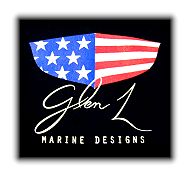
GLEN-L boats, of course
